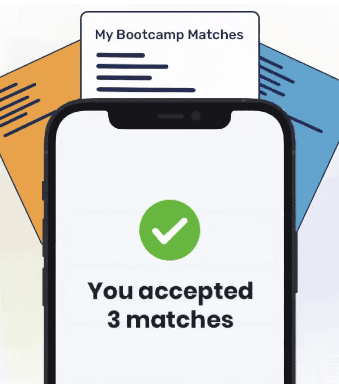For aspiring backend programmers, learning Node.js is important. Its widespread use across websites, applications, and software in the tech industry makes it a tool worth learning. This popularity also means that developers who learn Node.js and can use it professionally are in high demand.
But knowing how to learn Node.js is just as crucial as mastering the framework itself. Learning styles, budgets, and resources are important factors to consider when you want to learn Node.js. This article explores all of these factors to help you find the best way to learn Node.js and become a backend developer.
What Is Node.js?
Node.js is an open-source, cross-platform JavaScript runtime environment used to execute JavaScript outside of the browser. It is a lightweight and easy framework to learn for frontend developers because it incorporates JavaScript into the backend server without having to learn another language.
A server, with use of a representational state transfer application programming interface (RESTful API), is an event-driven backend that uses endpoints to perform logic whose result will be transferred to the frontend so that the frontend developer can use it on the client side.
Why Should You Learn Node.js?
You should learn Node.js because it is a popular runtime environment often included in the tech stack for the backend service of websites. It is used on the server-side to test applications outside of a browser environment. Learning Node.js is important for the creation of real-time streaming apps and network applications that require the significant use of a database.
So, why learn Node.js now? Having an understanding of this tool means you will have many job opportunities available to you. Because it is widely used, many companies, platforms, and websites need Node.js developers to maintain their online presence.
How Long Does It Take to Learn Node.js?
Learning Node.js could take anywhere from three months to two years depending on how much time you can dedicate to studying the language. It also depends on how much prior coding experience you have before beginning. Having an understanding of programming fundamentals will make it quicker to learn Node.js.
Ultimately, though, learning Node.js will never truly end. You will eventually become an expert as long as you keep learning. The language and the runtime environment are ever-evolving and learning about those changes will take continued reading and education.
How to Learn Node.js: Step-by-Step Guide
Knowing how to learn Node.js most effectively starts with having a learning plan. This will help you stay organized and master the fundamentals in the most effective and efficient way. Below is a step-by-step guide on how to learn Node.js.
Step 1: Determine Your Motivation
First, you need to consider why you want to learn Node.js. This will help you discover your motivation for learning which will help propel you through the challenging moments of learning the framework. Below are some questions you should ask yourself before you begin:
- Is there a particular reason why you want to learn Node.js specifically?
- Do you have an end goal in mind?
- What purpose will Node.js serve for your project or career?
- What does the future hold as far as job prospects go?
If web development, particularly backend development, was part of your answer at all, you’re on the right path.
Step 2: Learn Node.js By Mastering JavaScript Fundamentals
You won’t be able to get started in Node.js development until you have a firm grasp of JavaScript fundamentals. The following is a checklist of topics you need to master before moving on to the creation of backend applications that will serve a full stack project.
JavaScript Fundamentals to Master
- Learn how to create a small program to test Node.js Environment
- Learn the difference between let, const, and var when it comes to variables
- Use typeof to learn differences between data types
- Logging statements to the JavaScript console
- Arithmetic Operations, including add, subtract, multiply, divide, and modulo
- Comments, both single line and multi-line
- Be able to write a traditional if-else statement and a ternary statement
- Traditional For Loops (ES5)
- Advanced Array Methods, including map, reduce, filter, and forEach (ES6)
- Named Functions
- Anonymous Functions
- Higher Order Functions
- Be sure to know what asynchronous JavaScript is and how it’s used
Backend Basics to Learn Node.js
- Use npm or yarn to install Node.jsmodules that can be used in your backend server
- What is an HTTP Request and how it works
- Express.js and other Node.js frameworks to use as part of your backend application
- Cross-Origin Resource Sharing (CORS)
- Difference between SQL and NoSQL Databases
- Learn how to create a RESTful API
This list is by no means comprehensive. There are many other topics in the Node.js world that can be learned. These topics are the absolute bare minimum you should master to become a well-rounded Node.js developer. In the next section, after the step-by-step guide, we’ll take a look at some of the more popular free Node.js tutorials to get you started.
Step 3: Build Projects
Incorporate your newfound knowledge into projects that use Node.js. Getting those reps in will not only solidify your knowledge of backend JavaScript and how to use it but will also help you create a portfolio-worthy code to show off to potential employers. Focus on building projects that display your understanding of the backend of a desktop application and a modern web application, for example.
Node.js Project Ideas
- Create a RESTful API that has endpoints to create, read, update, and delete entries in a directory of some sort. Use a NoSQL database to store your information.
- Add on to the first project by adding registration and login endpoints. Allow only logged-in users to create, update, or delete an entry.
- Use Socket.io to create a chat application between two people.
Step 4: Join Programming Communities
Finding a Node.js community to join will help accelerate your learning and provide needed help when you get stuck in your learning. A Node.js community is a group of developers of various levels who collaborate to answer questions, discuss the framework, and even work on building web applications together.
Best JavaScript Communities to Master Node.js
- Node Slackers. This Slack community for Node.js is open to programmers of all skill levels and includes working groups.
- OpenJS Foundation. Found on Slack, the OpenJS Foundations has discussion channels and working groups for Node.js beginners, intermediates, and experts in the language.
- Nodeiflux. This Discord channel has a community of backend developers who are both studying or working professionals. It boasts 7,840 members who aim to share knowledge and help others grow professionally.
Step 5: Join a Coding Bootcamp
One of the best ways to learn Node.js is to study at a coding bootcamp. With Node.js being such a popular programming language, there are many options for bootcamps. Bootcamps are intensive learning programs that impart job-ready skills to students in a matter of months. They focus on developing these skills through comprehensive courses.
In many cases, learning Node.js is part of a bootcamp curriculum, which is typically designed to make graduates full stack developers or backend developers. This well-rounded education means you will understand how to code in Node.js and how to develop a website. The Tech Academy and Simplilearn both offer bootcamps in full stack development.
Step 6: Progress to More Difficult Projects
Progress toward more difficult projects by adding a front end to your already created backend project and making it work so it looks great when a user interacts with it online. Try using all kinds of databases to practice using the different types so you know when to choose one over the other. Lastly, take a look at projects you have already created to see if they can be made more efficient.
Node.js Advanced Project Ideas
- Collaboration tools like Zoom or Google Hangouts
- Web scraping a website to get information
- URL/link shortener
- Work on an open-source project and create a Pull Request for it
Step 7: Begin Freelancing to Garner Experience
After finishing your Node.js curriculum, and building some projects that showcase your range of knowledge in Node.js, try reaching out to find freelance work. By completing freelance work, you’ll be able to gain real-world experience in completing a functioning website and hone your soft skills in communication, time management, and project management.
Having this kind of experience to add to your professional programming resume will help you land a developer job more quickly. Be sure to request a testimonial of work from the clients you work with to showcase during your job hunt.
Best Way to Learn Node.js Online
The best way to learn Node.js is by going through Node.js tutorials and courses. You can choose a course based on your experience level, and some courses are even free. Read below to learn more about the best Node.js tutorials to help you advance your software developer skills and how you can learn Node.js online free of charge.
Best Node.js Tutorials for Beginners
Node.js tutorials are quick ways to master Node.js topics. Node.js tutorials for beginners especially focus on fundamentals and teach them in an approachable way. Some tutorials are grouped into entire courses, keeping your learning all in one place. Below are some of the best Node.js courses and tutorials to launch your Node.js education.
Node.js Tutorials
Tutorials Teacher features Node.js tutorials for programmers to learn basic concepts of the open-source server environment. The tutorials will teach you fundamental to advanced levels of the environment using Chrome’s V8 JavaScript engine. You will find the tutorials in different sections featuring multiple topics.
The beginner-friendly tutorials have a step-by-step guide that makes them easier to understand. However, you will still need background knowledge in HTML, JavaScript, and web applications. To establish if you are ready for the tutorial, you can sit for the 20-question quiz offered on the platform. The quiz does not have any time limit.
Learn Node.js Tutorial
You can master Node.js by going through TutorialsPoint’s resources. The step-by-step tutorial will teach you the fundamentals of Node.js with single-page applications, streaming sites, and building an actual application. It’s an excellent platform for software developers who want to learn the basics of Node.js and its multiple architectural concepts.
Before you delve into the tutorial, it is essential to have background knowledge in JavaScript. It’s a beginner-friendly course, but having a basic understanding of JavaScript will ease the learning process. You should also have experience in programming languages or technologies such as HTML, AJAX library, or CSS.
The Node.js Master Class
This master class will take you through the entirety of Node.js. Pirple curated the course for only $197 to help students master all the Node.js concepts and APIs. You will understand V8, the architecture of Node.js applications, and different Node.js conventions. The course also touches on building a real-world RESTful API.

"Career Karma entered my life when I needed it most and quickly helped me match with a bootcamp. Two months after graduating, I found my dream job that aligned with my values and goals in life!"
Venus, Software Engineer at Rockbot
You will also learn how to add configurations, route requests, and add HTTPS support. By the end of the tutorial, you will also know how to build a web application GUI. This means creating, editing, deleting an account, creating and deleting a session, and creating a check. The platform also features videos on building a CLI and how to gain stability and performance.
Introduction to Node.js
Learning about Node.js can help you seamlessly develop multiple server-side applications. Node.js has its own excellent introductory tutorial to help practitioners advance in tech. The tutorial teaches about different libraries that effectively support networking. Students also learn about Node.js frameworks and tools.
You will learn Express, Egg.js, Adonis.js, Fastify, or HAPI. These are relevant libraries that are in use by the Node.js developer community to build real-world applications. You will also receive multiple documentation on Node.js API referencing, ES6, and guides featuring technical aspects of the platform.
Node.js Tutorial: Learn in 3 Days
A beginner in the field can go to the advanced level by going through the Guru99 three-day tutorial. In the first lessons, you will learn how to download and the installation process of Node.js. You will also learn different Node.js core modules, how to create HTTP web servers, and scalable network applications.
This tutorial will give you an in-depth view of GraphQL and Rest. You will learn the major differences between Node.js vs Python. To ensure you land a job after your coding education, the platform also features possible Node.js interview questions and provides a tutorial for complete beginners.
Best Advanced Node.js Tutorials
To take your knowledge to the next level, advanced Node.js tutorials can take you through higher-level Node.js programming. These tutorials provide all the knowledge required to find work in the industry as a Node.js programmer. Read on below for our top choices.
The Complete Node.js Developer Course (3rd Edition)
Udemy provides a 36-hour tutorial for professionals to master Node.js by building a real-time application from scratch. The third edition will take you through three programming languages, namely Node.js, Express, and MongoDB. You will learn about debugging Node.js applications and asynchronous programming.
If you want to master how to create web servers and APIsin Express, you should consider this advanced tutorial. It also features lessons on building, testing, and launching Node.js applications. The content delves deeper by teaching students how to access APIs from a browser and application deployment.
Node JS: Advanced Concepts
Udemy provides yet another advanced course to help professionals master all the advanced concepts of Node.js. For only $90, you will grasp the event loop, worker threats, browser automation, and how to utilize AWS S3. It is an excellent course for professionals who want to add skills to their resumes or simply strengthen their existing knowledge.
In 16 hours, you will master C++ , fundamentals of Threads, Node.js Event Loop Ticks, testing Single Threads, and Libuv Thread Pool. You will also learn the multiple Thread Pools, how to change the size of the Threadpool, and explain OS operations. Udemy also ensures you learn to enhance Node.js performance and automate headless browser testing.
Advanced Node.js
You can go through Pluralsight’s advanced Node.js tutorial to increase your knowledge. This tutorial will help you to master all the concepts of Node.js in under four hours. You will learn Node.js architecture, Node’s CLI, and C++ addons. The video tutorial teaches event loop, event-driven architecture, and Node.js for networking.
This is an excellent online course for you to take your skills for building projects to the next level. You will learn child processes, event loops, strand, and module management. You will also learn to be proficient in modern JavaScript, the fundamentals of Node.js, and building a server-side application.
Code with Node: Learn by Doing
DevSprout features an online tutorial that helps professionals gain deep insight into creating production-grade functionalities and features for a web application using Node.js and Express.js. This tutorial will teach you ES6, geospatial indexing, search, pagination, or image uploading step by step.
You will learn Bootstrapping of Express design, models, user routes, post resources, and user authentication. You will also learn how to upload images using Cloudinary and set up geolocation using Mapbox. You can access the 30-minute tutoring service at $100 or the one-hour service at $200.
Node with React: Fullstack Web Development
Udemy features a 25-hour tutorial to help professionals learn how to build projects using Node.js, React, Redux, and Express. In the online course, you will learn all the major deployment techniques and web technologies. By the time you complete this course, you will know server-side development, authentication with Google, and how to add MongoDB.
This course requires you to have some knowledge of JavaScript, React, and Redux. It is a relatively demanding course that will help you combine skills in Express and MongoDB through building a full stack web application. By the time you finish, you will have a fully functional Node.js application that can send emails to different users.
Best Free Node.js Tutorials
The best free Node.js tutorials allow you to learn both fundamental and advanced concepts without paying a penny. Free tutorials and courses make learning Node.js more accessible as not everyone can afford to pay thousands of dollars for bootcamps. Below are some of the top free Node.js tutorials today.
Node.js: Getting Started
Pluralsight offers a tutorial to help professionals learn Node.js from scratch. This training will help you strengthen your software development skills. This tutorial is taught by advanced developers. You will gain real-world experience to help you land a job at top-tier tech companies like LinkedIn and Netflix.
This tutorial covers REPL Mode, executing scripts, and working with timers and command-line interface. You will also touch on modern JavaScript concepts and techniques as well as variables, arrow functions, object literals, template strings, and classes. By the end of the course, you will have in-depth knowledge of Node.js.
Node.js Tutorial
W3Schools is a popular platform offering different coding courses, tutorials, and resources to experienced developers and beginners in the field. The platform features multiple examples to help professionals learn about Node.js through examples. You can also try out your own code in the command line interface.
In addition to live examples, you will find built-in modules and downloadable Node.js resources from the official website. Students will learn how Node.js uses asynchronous code as well as its features and functionalities. These tutorials are a great way to learn this popular framework, and even an experienced developer can benefit.
Node.js Basics
Academind takes professionals through introductory to advanced levels in Node.js through 27 video tutorials on YouTube. The video tutorials will teach you how to build your first application as well as multiple JavaScript modules and functions for this runtime environment. Before you start, you should know at least one programming language.
You will also learn how to render HTML as response and routing. The free tutorial also touches on MongoDB, Mongoose, and Monk. You will learn how to update, modify and delete data on MongoDB after setting it up. This is tutorial video is one of the most accessible Node.js tutorials out there for learning server-side code.
Node Js Tutorial for Beginners: Getting Started with Node
Smartherd features 27 video tutorials to help professionals learn all the fundamentals of Node.js. By going through the tutorials, you will learn the fundamental skills to create scalable and reliable backend services using Node.js. You will also learn multiple tools that come with Node.
Smartherd also features step-by-step tutorials about package management, event-driven strategies, and writing code on interfaces. To complete the tutorial, you will learn modern aspects of JavaScript to use with Node.js.
Learn Node.js and Express
freeCodeCamp features an eight-hour tutorial to help professionals learn core concepts of Node.js and Express. John Smilga, an instructor, will help you learn the basics of Node.js and Express. He will also teach you the process of building a Rest API web application. You will also build a MERN application and multiple Node.js projects.
The YouTube tutorial will also take you through HTTP Intro, NPM Command, Global Install, Event Loop Slides, and Events Emitter. This will help you learn how to create data-intensive real-time applications at no cost. You will also learn about database access and how to avoid application errors.
Node.js Tutorial for Beginners
This YouTube playlist is a pretty comprehensive first look at Node.js and how it works. The first couple of videos start completely from installation on your respective operating system to diving directly into concepts that will help you to create a server to handle multiple HTTP requests. Really great, free resource!
Other Node.js Resources
If an online Node.js course isn’t necessarily right for you, there are other resources you can use to learn the programming language. Below are some of these other resources, including Node.js books that teach Node.js and JavaScript.
Eloquent JavaScript
Eloquent JavaScript is one of the gold standards in reference to learning how to write JavaScript with best practices. This book is a fantastic resource for solidifying concepts you have learned with some of the beginning JS tutorials mentioned above. It also talks about how HTTP and Node.js works.
It is in an online book format with a built-in IDE for end-of-chapter exercises. If you prefer an actual tangible product, there is an option for purchasing as well.
JavaScript for Cats
JavaScript for Cats uses felines to illustrate popular JavaScript concepts. It’s a great single-page basic primer on how the language works, covering many topics from variables to callback functions. Use this to understand basic concepts before going on to more advanced topics.
Freecodecamp
Apart from the course highlighted above, freeCodeCamp offers other interesting courses to learn Javascript and Node.js. Its basic JavaScript course teaches you the programming language with ES5 syntax. Students then graduate to a separate curriculum with ES6 syntax.
This prepares you for interviews where you are asked to describe your methods. For example, you could be asked about the difference between a variable declaration with ES5 keyword “var” vs. a variable declaration using the ES6 keyword “let.”
In addition, freeCodeCamp offers an API and Microservices Certification that includes a curriculum on using npm, basic Node.js, and Express, and more. Node.js Package Manager (npm) is just that – a package manager that allows you to add modules to your application.
Express is a Node.js framework that makes setting up a server on the backend incredibly simple. freeCodeCamp works well in this regard with its presentation of the material. The learning platform uses testing to make sure you have mastered the material before it shows that you have completed it.
Should I Learn Node.js?
When learning Node.js, we have to take a look at JavaScript and learn the idiosyncrasies of that language to move forward. Once mastered, we can then use that knowledge to create backend applications that will eventually interact with frontend applications to create a full stack web application.
Learning JavaScript and being able to translate it to work in your Node.js project is not easy. It’ll take some time, but the payoff will be worth it once you get that first working application under your belt.
Learn Node.js FAQ
Yes, a beginner can learn Node.js. However, they would need prior knowledge of JavaScript. There are many courses, tutorials, and bootcamps that are designed for Node.js beginners to learn Node.js with no prior knowledge of the framework.
Is Node.js easy to learn?
Yes, Node.js is easy to learn if you have an existing understanding of JavaScript. Node.js is a backend tool, and programming for the backend can be more challenging because it focuses on the functioning of a website or program rather than its structure or look.
How can I learn Node.js for free?
You can learn Node.js for free from YouTube, freeCodeCamp, and from other online resources designed for people on a budget. Some paid courses even offer free trials, and you may be possible to complete the entire course before the trial is up.
Is Node.js worth learning?
Yes, Node.js is worth learning if you plan to work in backend development. This is an important and popular framework that will open many doors for you in the job market. If you plan to be a full stack developer, knowing Node.js will also be important as you will conduct backend work as well as front end development.
About us: Career Karma is a platform designed to help job seekers find, research, and connect with job training programs to advance their careers. Learn about the CK publication.



